Site NE42
Property: Rutherglen Research Institute.
Paddock No.: 17.
Australian Soil Classification: Vertic, (and Calcic), Mottled-Mesonatric, Grey SODOSOL.
Northcote Factual Key: Dy 3.43.
Great Soil Group: Solodic soil.
General Landscape Description: Lower part of a plain associated with Black Dog Creek.
Soil Mapping Unit: Black Dog fine sandy loam. NOTE: This soil profile more closely resembles Lilliput Loam.
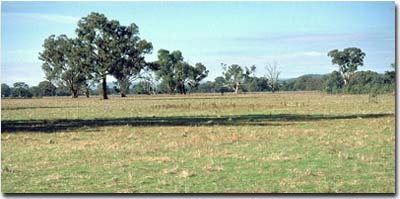 Site NE42 Landscape |
Soil Profile Morphology:
Surface Soil
| 0 | 0-1 cm | Organic mat; sharp change to: | 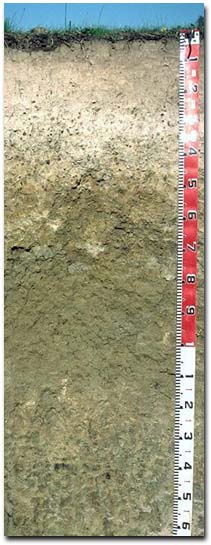 Site NE42 Profile |
| A1 | 1-8 cm | Brown (7.5YR4/4); fine sandy loam; weak coarse blocky structure; firm consistence dry; contains a common (15%) amount of ferro-manganiferous nodules (5-12 mm size); pH 4.9; abrupt change to: | |
| A2 | 8-45cm | Pinkish white (7.5YR7/4) conspicuously bleached (10YR8/3d); loamy sand; structureless; weak consistence dry; pH 5.6; abrupt and wavy change to: | |
| Subsoil | |||
| B21 | 45-60 cm | Light brownish grey (2.5Y6/2) with yellowish red (5YR5/8) and faint brownish yellow (10YR6/6) mottles; light medium clay; moderate coarse blocky, parting to moderate medium blocky structure; strong consistence, moderately moist; contains a few (5%) ferromanganiferous nodules (10 mm size); pH 7.6; gradual change to: | |
| B22 | 60-75 cm | Light brownish grey (2.5Y6/2) with faint brownish yellow (10YR6/6) mottles; light medium clay; weak coarse prismatic, parting to strong coarse blocky structure; strong consistence, moderately moist; contains a common (10%) amount of manganese stains; pH 8.6; clear change to: | |
| B23 | 75-95 cm | Light yellowish brown (2.5Y6/4) with olive yellow (2.5Y6/6) diffuse mottles; medium clay; moderate coarse prismatic, parting to strong coarse blocky structure; strong consistence moderately moist; many slickensides present; pH 8.9; clear change to: | |
| B31k | 95-120 cm | Pale brown (10YR6/3); medium heavy clay; strong very coarse prismatic structure; firm consistence moist; contains a few (2-5%) silica and carbonate nodules (2-50 mm size); pH 9.2; clear change to: | |
| B32 | 120-140 cm | Light olive brown (2.5Y5/4); light medium clay; moderate coarse prismatic, parting to moderate coarse blocky structure; very firm consistence moderately moist; pH 9.3; gradual change to: | |
| B33 | 140 cm+ | Dark yellowish brown (10YR4/4); sandy clay loam; moderate coarse blocky structure; strong consistence moderately moist; contains a few (5%) manganese stains; pH 9.3. | |
Key Profile Features:
- Strong texture contrast between surface (A) horizons (<10% clay) and subsoil (B21) horizon (47% clay).
- Conspicuously bleached subsurface (A2) horizon.
- Vertic properties (i.e. slickensides present) in deeper subsoil.
 | The surface horizon is very strongly acid. The subsurface (A2) horizon is moderately acid. The upper subsoil is slightly alkaline and the deeper subsoil becomes very strongly alkaline. | 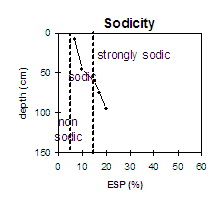 | The subsoil is strongly sodic throughout. Strong to complete dispersion occurs. |
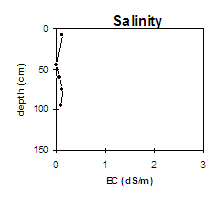 | The salinity rating is very low for the upper profile and becomes low at about one metre depth. | 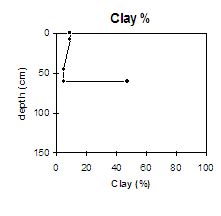 | The clay percentage increases significantly at the A/B horizon interface. |
Horizon | Horizon Depth (cm) | pH (water) | pH (CaCl2) | EC 1:5 | Exchangeable Cations | Exchangeable Aluminium mg/kg | Field Capacity pF 2.5 | Wilting Point pF 4.2 | Coarse Sand (0.2 -2.0 mm) | Fine Sand (0.02 -0.2 mm) | Silt (0.002 -0.02 mm) | Clay (<0.002 mm) | |||
Ca | Mg | K | Na | ||||||||||||
meq/100g | |||||||||||||||
A1 | 1-8 | 4.9 | 4.1 | 0.12 | 1.1 | 0.25 | 0.51 | 0.14 | 55 | 20 | 5 | 17 | 54 | 16 | 9 |
A2 | 8-45 | 5.6 | 4.4 | <0.05 | 0.28 | 0.08 | 0.18 | 0.06 | 17 | 15 | 2 | 19 | 60 | 16 | 5 |
B21 | 45-60 | 7.6 | 6.1 | 0.06 | 3.8 | 6.5 | 0.53 | 1.8 | 31 | 19 | 11 | 32 | 9 | 47 | |
B22 | 60-75 | 8.6 | 7.1 | 0.11 | 4.6 | 9.7 | 0.61 | 2.9 | 34 | 19 | 6 | 33 | 11 | 50 | |
B23 | 75-95 | 8.9 | 7.5 | 0.09 | 5.3 | 13 | 0.6 | 4.5 | |||||||
B31k | 95-120 | 9.2 | 8.2 | 0.3 | 5.6 | 14 | 0.6 | 4.9 | |||||||
B32 | 120-140 | 9.3 | 8.2 | 0.23 | 7.3 | 12 | 0.82 | 3.9 | |||||||
B33 | 140+ | 9.3 | 7.9 | 0.12 | 3.8 | 7.7 | 0.41 | 2.8 | |||||||
Management Considerations:
Whole Profile
- Plant available water capacity (PAWC) is considered to be low (estimated at 80 mm) for the top metre of the soil. This is based on available laboratory data. Effective rooting depth is, however, likely to be significantly lower than 1 metre in this profile due to the strongly sodic subsoil conditions. Therefore, PAWC is likely to be very low.
- In very strongly acid soils, manganese and aluminium solubility can increase to toxic levels. However, the level of exchangeable aluminium measured in the laboratory is only moderate (55 mg/kg) and unlikely to significantly restrict the growth of aluminium sensitive species. A pH/aluminium test performed on a bulked sample (taken across the paddock) would be most appropriate.
- The hardsetting surface soil has a high fine sand and silt content (70 %). Organic matter is therefore very important for maintaining aggregation and preventing slaking. Cultivation in a dry condition can be deleterious to soil structure as the soil will become 'powdery' and subsequent rainfall may result in surface sealing occurring.
- Both surface horizons have a very low nutrient status (based on the sum of the exchangeable basic cations).
- The subsurface (A2) horizon will become 'soupy' when waterlogging occurs on top of the poorly permeable subsoil. This is because of the very high fine sand and silt content and resultant low liquid limit which means that there is little cohesive strength when saturated.
- The relatively low wilting point value (i.e. 5%) indicates that plants will be able to utilise light rains falling on relatively dry soil.
- The subsoil is strongly sodic, has a low calcium:magnesium ratio and disperses completely. As a result, subsoil permeability will be very low and aeration will also be restricted.
- The deeper subsoil displays vertic properties (i.e. presence of slickensides). This indicates that significant shrinking and swelling occurs in the deeper subsoil.
- Manganese segregations in the subsoil may have a toxic effect on sensitive species.
- Cultivated in 1977 and disc cultivated in 1984.
- Top-dressed with 1 t/ha of lime in 1984 and 29 bags super, lime and Mo in 1986.


